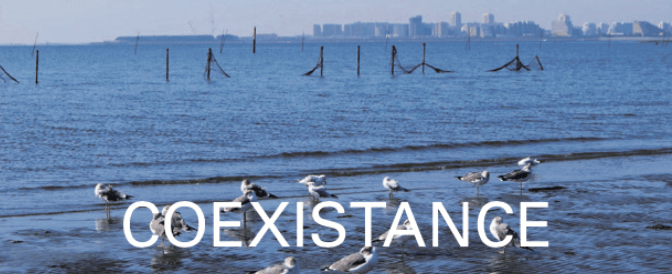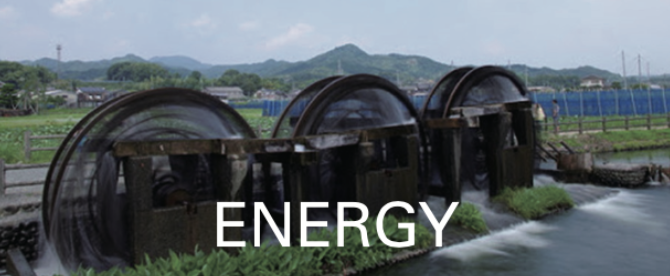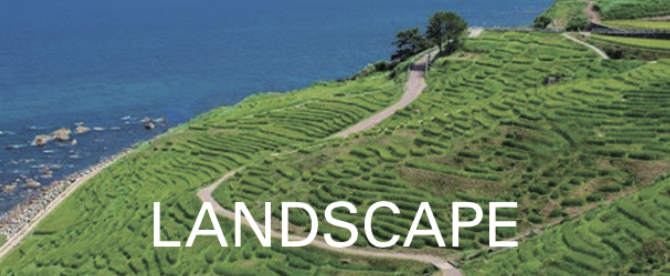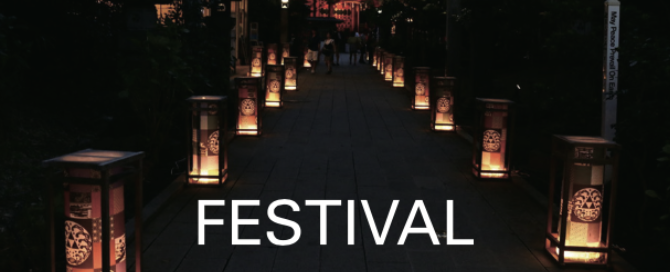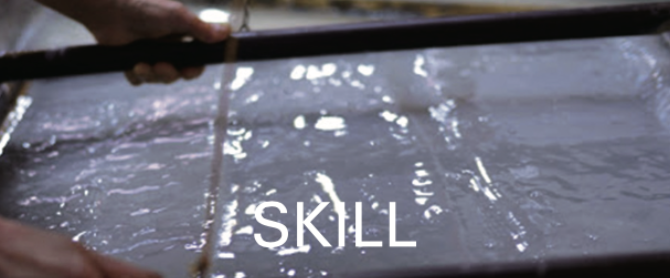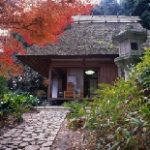
Kara-hashi, Bridge of Seta is a bridge crossing over the Setagawa River, which is the only river flowing out of the Biwa Lake. Tokaido, the route connecting Kyoto and Edo Tokyo in the Edo period, passed this bridge, in the 17th-19th centuries. The scene of this bridge in the sunset was painted by Utagawa Hiroshige (1797 – 1858), a Japanese ukiyo-e artist. He drew the pleasures of the city and travel, using woodblock prints and painting, as Omi Hakkei, Eight Views of Omi. It’s beauty was known over the Japan.
Chikatsuo shrine is located to the west of this bridge, 15 minutes by car. There is Genjuan, hermitage, where Matsuo Basho (1644 – 1694), the most famous poet of the Edo period, lived for about 4 months, after he completed his travel of Oku no hosomichi, the Narrow Road to the Deep North.
It was a major text of travel poems and essays. You can imagine the elegance at the end of his life in the sunset. This was the last chapter of the elegance of poetic unconventionality in the Japanese early modern times.
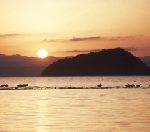
This island surrounded by a 2km sheer cliff, floats about 6km far from the lake shore of Nagahama city, Shiga at the northern end of Lake Biwa. The island has a history of syncretizing the goddess of Lake Biwa, Azaihime no mikoto, who was worshipped here to ensure the safety of water traffic on the lake, and Sarasvati, the god of wealth, music eloquence and water. The name of this island came from “Kami Ituku Sumai,” the place where the Gods reside.
The shadow of this island in dark green is one of Omi Hakkei, Eight Views of Omi. The scene of the island from Nagahama is extremely magical.
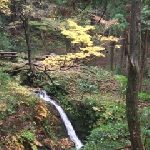
Kenryu gorge is located at the northern end of the Gozu prefectural natural park. It is easily accessible from the city. Giant stone rocks and clear streams are there and cedar trees and broad-leaved trees spread out. You can feel that the original landscape of Japan still remains.
Moreover, You can feel the “Suishin, Transparent Mind”in indian ink ,which came from Huainanzi, the ancient Chinese encyclopedia of the Former Han dynasty (BC206-8).You can also feel Yaichi Aizu’s belief that academic knowledge and insight should be nurtured, cultivated, and infiltrated, naturally.
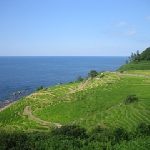
The Rice Terrace is in Shiroyonemachi Wajima City Ishikawa Prefecture, with just under 4ha of land and small rice fields, layered up its slope. However, the site has a rich soil and those rice fields use water from the valley, without relying on agricultural chemicals. In 2011, the rice Terrace was listed as Globally Important Agricultural Heritage System, along with Noto’s Sotoyama and Satoumi.
Wajima has been facing and connecting the sea since ancient times. There is also the Wajima Taisai – Wajima Festival, in which the Goddess of Hegurajima Island and the God of Land in Wajima meet with a torch, as a landmark. The festival weaves fire and water to create the purity.

This Observatory, constructed around Mt. Tomo (48m), overlooks the Rias coast of Ago Bay and has truly scenic and majestic views of the sea of Shima. Shima province was independent of Ise province, from the late 7th Century to the early 8th Century.
In the Manyoshu anthology of Japanese poetry in the 8th Century, Shima province emerged as a source of rich sea food for the Emperor. You can feel the richness of Shima province here.

This museum was built to blend in with the beautiful scenery of the Shinji Lake, to harmonize with the water. It exhibits domestic and foreign paintings, crafts, photographs, and sculptures, etc. Fujinayaki Seto-utsushi Mizusashi, a pitcher of pottery for a Japanese Tea Ceremony – A gracious figure, with a natural look, fully covered in brown glaze. It is the work from a kiln of the Domain by Matsudaira Harusato Fumai (1751 – 1818), the 7th lord of the Matsue Domain. “A generously sophisticated beauty.”
This museum remains open 30 minutes after the sunset, from March to September, so that you can enjoy the sunset on the Shinji Lake, which was selected as one of the 100 Most Famous Sunsets in Japan.

Takagai no Ishitsumi is about 3 km by foot from an Open-air museum. Misato Hotaru Museum, the firefly museum, has stonework selected as a Cultural landscape by the Agency for Cultural Affairs.
The stonework was piled up to stabilize and preserve steep farmland, for more than 300 years. It could not have been created at once. Even if it was mechanically piled, it could not have lasted for 300 years.
The stonework is lit up and its emergence awakens us to the truth.
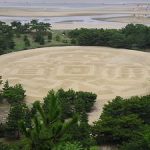
The park has the sand picture of Kanei Tsuho, copper coin from the Edo period (1603 – 1868), in 122m east-west, 90m north-south and 345m in circumference, which is famous in Japan through TV historical drama. The picture shows the beauty of Ariakehama Beach and pine, as Hakusa Seisho: a beautiful stretch of sandy seashore dotted with pine trees.
You can see the entire stretch from the summit of Mt. Kotohikiyama, in this park of about 38.6ha in size. You can also see the Chugoku Mountains, where Mt. Kotobikisan stands. In mythology, Okunushi no Mikoto: the deity of magic and medicine, and originally the ruler of Izumo Province, Shimane, was enshrined at Izumo Grand Shrine at Mt. Kotobikisan. Okunushi no Mikoto dedicated Koto (a Japanese harp).
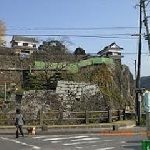
This castle is the sea castle built by Ootomo Sorin (1530 – 1587) a feudal lord who converted to Roman Catholicism in 1556. This castle was the headquarters of Ootomo Sorin to prepare for the invasion of the Mouri clan, one of the most powerful feudal lords of the Tokugawa shogunate in the 17th – 19th centuries.
At that time, it was built on Nyujima Island, which had a precipice on all sides and floated along from east to west, in Usuki Bay. After the Battle of Sekigahara in 1600, the Inaga clan moved here from Gujyo Hachiman Mino Province, Gifu, and they became the lord of this castle.
After that lordship had continued, this castle met the Meiji era when the Samurai days ended. The Inaba clan served Oda Nobunaga (1534 – 1582), the legendary warlord and the military dictator.
The mother of Inaba Norimichi (1566 – 1626) a feudal lord, the second lord of the Usuki Domain, was daughter of Saito Dosan (1494 – 1556) a feudal lord of the Mino province Gifu, stepfather of Nobunaga. The previous Domaine of the Inaba clan was the place of Kokin denju, the initiation about interpretation of Kokin Waka shu, the Imperial anthology in the 10th century. A family that knew Miyabi, Japanse elegance of Kokin Waka shu, inherited this Domain.

This castle was built in 1608, after the Battle of Sekigahara in 1600, with the demolished material of the impregnable Ngoyajo Castle in Hizen Province, Saga. This Honmaru, the keep of a castle, is at Mt. Mantosan in the northern part of Karatsu City. This castle was built by Terasawa Hirotaka (1563 – 1633) a feudal lord, who was a close aide of Toyotomi Hideyoshi (1537 – 1598), the powerful feudal lord and Imperial Regent who unified Japan.
Terasawa Hirotaka architected pulling the flow of the Matsuura River, opening the canal to the south side and opening its estuary on the east side for defense and ship transportation.
He also resembled the castle tower as the head of a crane and planted 1 million Japanese black pine trees in the sandbar during Keicho period of 1596 – 1615, which became Nijinomatsubara, a 360-year-old pine forest in Karatsu Saga, with a the width of 400 – 700m and a length of about 4km.
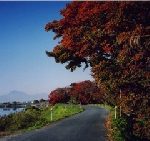
The water in Kikuchi River, from Mt. Aso, is famous as one of 100 Exquisite and Well-Conserved Waters. The embankment of the Kikuchi River is also famous for its row of wax trees.
It was said that the beginning of the row of wax trees came from the suggestion by Oishi Kuranosuke (1659 – 1703), the chamberlain of the Ako Domain in Harima Province and a leader of the Chushingura. Kuranosuke guided that the quality wax from cultivation of wax trees was profitable.
After that, wax making became the main policy at the Horeki Reform, the reform of Domain in Horeki era (1751 – 1764), in the southwestern Domains, which reconstructed finance of the Hosokawa Domain.
The rice shipped down the Kikuchi River from Takase Okura, a rice storehouse in the Edo period, was called Takase Mai, the rice of Takase, which became the base market price for rice.
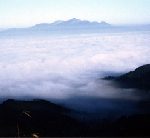
Ebino Basin in the Kagoshima-Miyazaki Prefectural Border, experiences a 10 degree temperature drop between daytime and nighttime in spring and autumn. In the early morning without wind, the whole area is hazy in the sea of clouds. At that time, a magnificent Kirishima Mountain Range from the Yatake Plateau with a sea of white clouds appears. In the Ebino and Miyakonojo Basin, the top of the mountain looks like an island and is named “Kirishima-Foggy Island”. The scenery overlaps “Shimazu no sho” which was the largest manor in Japan, in the Heian period (794 – 1185), and the original homeland of Japan, which the civilization from abroad saw over the sea, too.
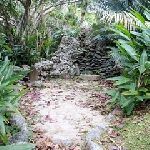
This village reproduces Okinawa villages during the Ryukyu Kingdom period. Private houses and elevated granaries are reproduced within a traditional form of village that consists of sacred sites (Utaki), water wells (Ugamigah) and Kami-asagi. The houses introduce the warm climate, cheerful personality, and the enshrining Utaki, a sacred water spring, reminds us of the wisdom of living life without disappointment by natural disasters, such as typhoons.
There is a man-made forest and a stone wall around the house with a low roof. The eaves are long and the whole room is open. The pleasant wind blows through the house. It offers various events that allow visitors to become familiar with Okinawa from the old days including Sanshin and Kachahshii experiences and seasonal events.
It holds various events that you can get to know the tradition of Okinawa. You’ll encounter Sanshin, a three-stringed Okiwana lute, and Kachashi, a dance that is performed with the fast-paced Okinawan folk song, with both hands above the head and swinging left and right while turning the wrist.
